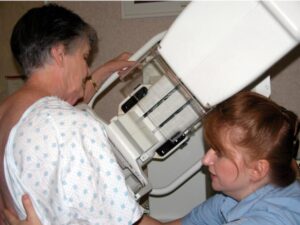While breast examinations can detect large breast tumors, smaller ones are often missed during a physical exam. By the time a developing breast cancer is large enough to be felt, it has often been present for up to several years. This is not early diagnosis.
Mammograms

In contrast, x-ray screening mammography, in use for decades, has been shown to decrease breast cancer related mortality. The decrease is felt to be due to earlier diagnosis and treatment of the cancer.
Specific mammogram techniques may vary from institution to institution (film vs digital vs full screen) and subtypes of mammograms are sometimes used in special circumstances (eg 3D mammograms or digital breast tomosynthesis)
The frequency of recommended mammogram screening also varies, but the NIH has observed:
Most guidelines recommend annual or biennial mammographic screening between 40 and 74 years for the average-risk populations and annual MAM or annual MRI starting from a younger age for the high-risk populations.
Ren W, Chen M, Qiao Y, Zhao F.
Global guidelines for breast cancer screening: A systematic review.
Breast. 2022 Aug;64:85-99.
doi: 10.1016/j.breast.2022.04.003. Epub 2022 Apr 19.
PMID: 35636342; PMCID: PMC9142711.
Ultrasound
While not particularly useful for screening purposes, breast ultrasound can be helpful in clarifying ambiguous findings, or as a followup to previously identified abnormalities.
Magnetic Resonance Imaging of the Breast
Breast MRI is clinically useful in a number of situations:
- Breast implants
- Previous breast surgery
- Clarifying ambiguous mammogram findings
- Screening in high-risk patients
- Evaluating response to therapy
